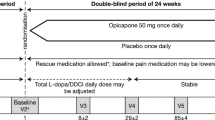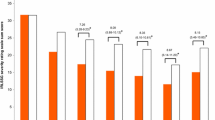Abstract
Pain is a relevant and often underestimated non-motor symptom affecting the quality of life of patients with Parkinson’s disease (PD). Although some pain symptoms can be effectively treated by dopaminergic medication, a correct diagnosis of the different types and distribution of pain in PD is challenging, and accordingly, its treatment remains troublesome. We evaluated the efficacy and the safety of a prolonged release oral formulation of oxycodone hydrochloride combined with naloxone hydrochloride dehydrate, in a fixed ratio of 2:1 (OXN PR). A total of 16 PD patients with history of pain with a minimum intensity of four on numerical rating scale (NRS) received low-dose OXN PR (5/2.5 mg twice daily) and were observed for a period of 8 weeks. The primary efficacy measure was the pain severity measured with NRS and Brief Pain Inventory (BPI). Secondary efficacy measured the safety profile by recording the occurrence of side effects, clinical global impression of change (CGI-C), Parkinson’s disease sleep scale 2 (PDSS-2), Bowel function index (BFI). Data were collected and analyzed using descriptive statistics. Patients who completed the study (14 out of 16) reported a significant pain relief as observed by the reduction of NRS and BPI scores. No adjustment of dopaminergic therapy was required. No significant changes were observed in bowel function and constipation symptoms as measured by the BFI during the 8-week period. Similarly, no changes were observed in PDSS-2 score, whereas an improvement was recorded by CGI-C compared to baseline. Low-dose oral OXN PR was efficacious for the management of pain symptoms of patients with PD. More importantly, patients did not experience significant side effects, such as constipation or sedation. Our study provides evidence that opioids can be used to treat pain symptoms in PD patients.


Similar content being viewed by others
References
Chaudhuri KR, Odin P, Antonini A, Martinez-Martin P (2011) Parkinson’s disease: the non-motor issues. Parkinsonism Relat Disord 17:E717–E723
Wasner G, Deuschl G (2012) Pains in Parkinson disease: many syndromes under one umbrella. Nat Rev Neurol 8:284–941
Ha AD, Jankovic J (2012) Pain in Parkinson’s disease. Mov Disord 27(485e):91
Beiske AG, Loge JH, Ronningen A, Svensson E (2009) Pain in Parkinson’s disease: prevalence and characteristics. Pain 141:173–177
Gallagher DA, Lees AJ, Schrag A (2010) What are the most important nonmotor symptoms in patients with Parkinson’s disease and are we missing them? MovDisord 25:2493–2500
Martinez-Martin P (2011) The importance of non-motor disturbances to quality of life in Parkinson’s disease. J NeurolSci 310:12–16
Perez-Lloret S, Rey MV, Dellapina E, Pellaprat J, Brefel-Courbon C, Rascol O (2012) Emerging analgesic drugs for Parkinson’s disease. Expert Opin Emerg Drugs 17(2):157–171
Berg D, Becker G, Reiners K (1999) Reduction of dyskinesia and induction of akinesia induced by morphine in two parkinsonian patients with severe sciatica. J Neural Transm 106(7–8):725–728
Snyder C, Mantione K (2014) The effects of morphine on Parkinson’s-related genes PINK1 and PARK2. Med Sci Monit Basic Res 7(20):63–69
Meissner W, Leyendecker P, Mueller-Lissner S et al (2009) A randomised controlled trial with prolonged-release oral oxycodone and naloxone to prevent and reverse opioid-induced constipation. Eur J Pain 13(1):56–64
Hughes AJ, Daniel SE, Kilford L, Lees AJ (1992) Accuracy of clinical diagnosis of idiopathic Parkinson’s disease: a clinico-pathological study of 100 cases. J Neurol Neurosurg Psychiat 55:181–184
Caraceni A, Mendoza TR, Mencaglia E et al (1996) A validation study of an Italian version of the Brief Pain Inventory (Breve Questionario per la Valutazione del Dolore). Pain 65(1):87–92
Bonezzi C, Nava A, Barbieri M, Bettaglio R, Demartini L, Miotti D, Paulin L (2002) Validazione della versione italiana del Brief Pain Inventory nei pazienti con dolore cronico. Minerva Anestesiol 68(7–8):607–611
Cleeland CS, Ryan KM (1994) Pain assessment: global use of the Brief Pain Inventory. Ann Acad Med Singap 23(2):129–138
Rentz AM, Yu R, Müller-Lissner S, Leyendecker P (2009) Validation of the Bowel Function Index to detect clinically meaningful changes in opioid-induced constipation. J Med Econ 12(4):371–383
Quittenbaum BH, Grahn B (2004) Quality of life and pain in Parkinson’s disease: a controlled cross-sectional study. Parkinsonism Relat Disord 10:129–136
Roh JH, Kim BJ, Jang JH, Seo WK, Lee SH, Kim JH, Oh K, Park KW, Lee DH, Koh SB (2009) The relationship of pain and health-related quality of life in Korean patients with Parkinson’s disease. Acta Neurol Scand 119:397–403
Politis M, Wu K, Molloy S, Bain G, Chaudhuri P, Piccini KR (2010) Parkinson’s disease symptoms: the patient’s perspective. Mov Disord 25:1646–1651
Pappagallo M (2008) Incidence, prevalence, and management of opioid bowel dysfunction. Am J Surg 182:S11–S18
Simpson K, Leyendecker P, Hopp M et al (2008) Fixed-ratio combination oxycodone/naloxone compared with oxycodone alone for the relief of opioid-induced constipation in moderate-to-severe noncancer pain. Curr Med Res Opin 24:3503–3512
Löwenstein O, Leyendecker P, Hopp M et al (2009) Combined prolonged-release oxycodone and naloxone improves bowel function in patients receiving opioids for moderate-to-severe non-malignant chronic pain: a randomised controlled trial. Expert Opin Pharmacother 10:531–543
Sandner-Kiesling A, Leyendecker P, Hopp M et al (2010) Long-term efficacy and safety of combined prolonged-release oxycodone and naloxone in the management of non-cancer chronic pain. Int J Clin Pract 64:763–774
Löwenstein O, Leyendecker P, Lux EA et al (2010) Efficacy and safety of combined prolongedrelease oxycodone and naloxone in the management of moderate/severe chronic nonmalignant pain: results of a prospectively designed pooled analysis of two randomised, double-blind clinical trials. BMC Clin Pharmacol 10:12
Acknowledgments
The study was completed independently. A restricted liberal erogation by Mundipharma srl, Italy, was obtained, aimed at supporting research activities. Mundipharma Italy had neither access to data, nor was involved in the preparation of the manuscript. The authors report no other conflicts of interest in this work.
Conflicts of interest
On behalf of all authors, the corresponding author states that there is no conflict of interest.
Ethical standard
The study has been approved by the appropriate ethics committee and have therefore been performed in accordance with the ethical standards laid down in the 1964 Declaration of Helsinki and its later amendments.
Author information
Authors and Affiliations
Corresponding author
Rights and permissions
About this article
Cite this article
Madeo, G., Schirinzi, T., Natoli, S. et al. Efficacy and safety profile of prolonged release oxycodone in combination with naloxone (OXN PR) in Parkinson’s disease patients with chronic pain. J Neurol 262, 2164–2170 (2015). https://doi.org/10.1007/s00415-015-7823-3
Received:
Revised:
Accepted:
Published:
Issue Date:
DOI: https://doi.org/10.1007/s00415-015-7823-3




